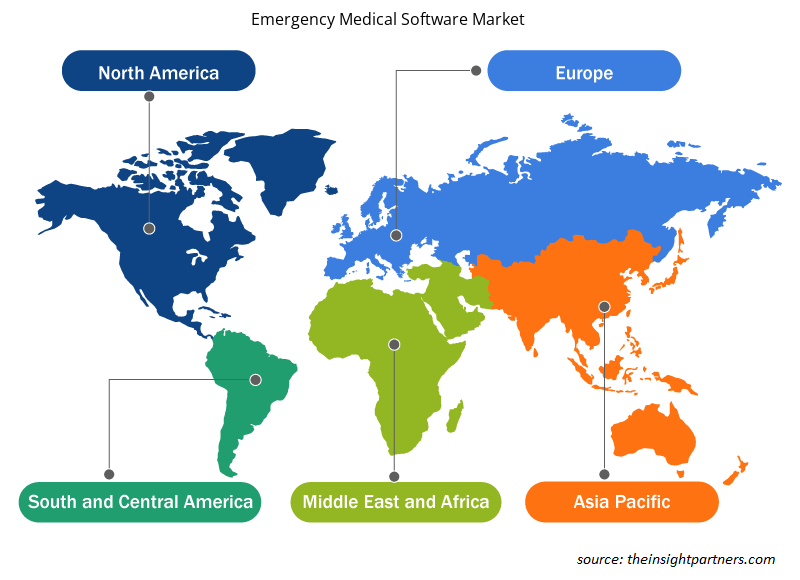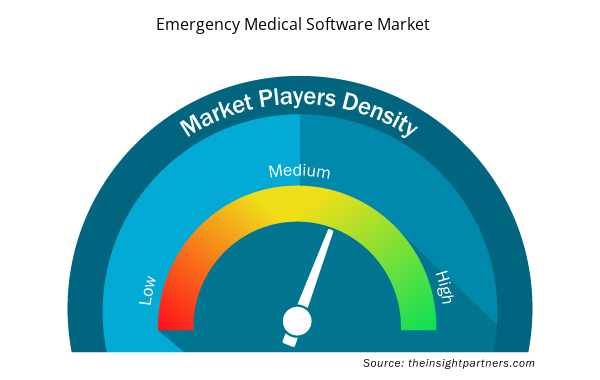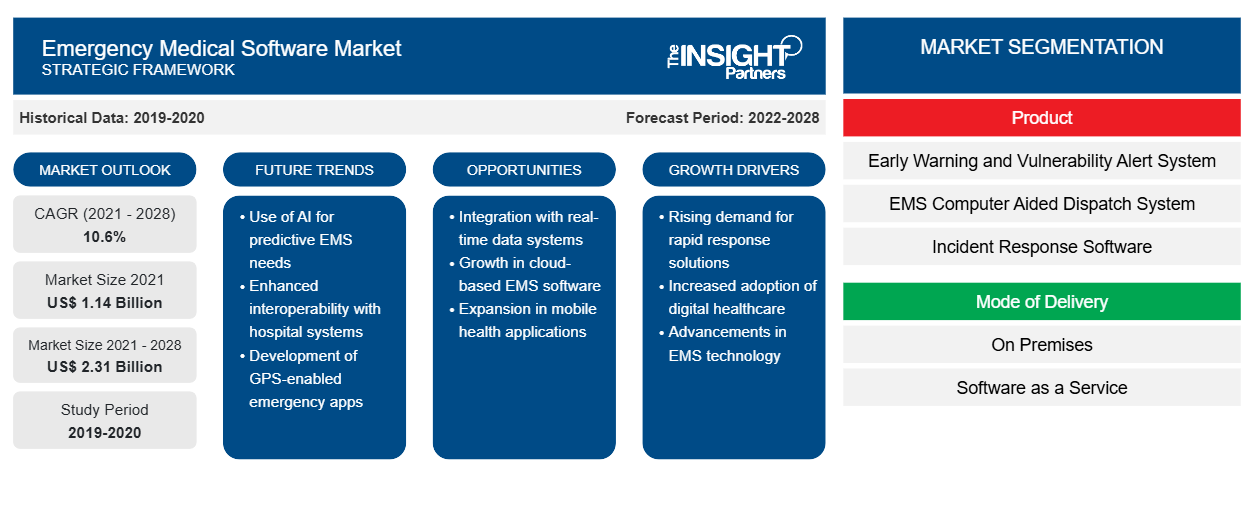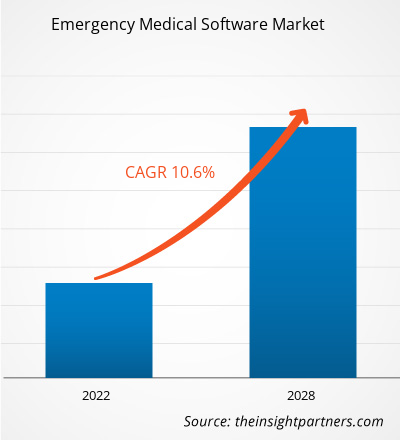急救医疗软件市场规模预计将从 2021 年的 11.4491 亿美元增至 2028 年的 23.132 亿美元;预计 2021-2028 年期间的复合年增长率为 10.6%。CAGR of 10.6% during 2021-2028.
急救医疗软件用于应对医疗事故并提供急救医疗护理。如果事故导致严重疾病或伤害,EMS 专注于对患者进行急救医疗护理。EMS 是一个协调响应系统和急救医疗护理,涉及多个人员和机构。综合的 EMS 系统包括事故识别、拨打 911、调度和预防意识。
急救医疗软件市场根据产品、交付方式、平台、最终用户和地理位置进行细分。按地理位置划分,市场大致分为北美、欧洲、亚太地区、中东和非洲以及南美和中美洲。急救医疗软件市场报告提供了对市场的深入分析和见解,强调了急救医疗软件市场规模、市场趋势、技术进步和市场动态等参数,以及对全球领先市场参与者的竞争格局的分析。
定制此报告以满足您的需求
您可以免费定制任何报告,包括本报告的部分内容、国家级分析、Excel 数据包,以及为初创企业和大学提供优惠和折扣
- 获取此报告的关键市场趋势。这个免费样品将包括数据分析,从市场趋势到估计和预测。
急救医疗软件市场的增长归因于创伤病例的增加和医疗费用的上涨。然而,熟练专业人员的短缺制约了市场的增长。
市场洞察
创伤病例不断增加
道路交通伤害等医疗紧急情况是全球主要死亡原因之一。根据世界卫生组织 (WHO) 的数据,2021 年,道路交通伤害导致约 130 万人死亡。此外,所有道路交通死亡人数中,超过一半是行人、骑自行车者和骑摩托车者。此外,世卫组织表示,全球 93% 的道路交通死亡事故发生在中低收入国家。预计道路交通伤害是 5-29 岁儿童和年轻人死亡的主要原因。此外,在酒精和任何精神活性物质或药物的影响下驾驶车辆会增加发生车祸的风险,从而导致死亡或严重受伤。这是导致对适当的医疗应急系统(例如事件响应系统和救护车管理软件)的需求激增的主要驱动因素之一。
2021 年,世卫组织表示,非传染性疾病导致 4100 万人死亡,约占全球死亡人数的 71%。此外,2019 年全球疾病负担报告显示,每年伤残调整生命年 (DALY) 约为 24.6 亿。这些死亡是由于过早死亡和长期残疾造成的。此外,据估计,中低收入国家超过 50% 的死亡和 40% 的总疾病负担可以通过院前和紧急护理避免。此外,全球可避免的可解决死亡总数和 DALY 分别为 2430 万和 10.23 亿。在南亚,90% 的死亡和 84% 的 DALY 是由于紧急情况和创伤造成的。因此,创伤病例的增加推动了紧急医疗软件市场的增长。
基于产品的洞察
根据产品,全球紧急医疗软件市场细分为预警和脆弱性警报系统 (EWVAS)、EMS计算机辅助调度 (CAD)系统、事件响应软件、救护车管理软件等。事件响应软件细分市场在 2021 年占据了最大的市场份额。此外,由于该产品在实践中使用最广泛,预计同一细分市场在预测期内将在市场上实现最高的复合年增长率。
基于交付模式的洞察
根据交付方式,全球急救医疗软件市场分为本地和软件即服务 (SaaS)。本地部分在 2021 年占据了更大的市场份额。然而,由于基于云的 SaaS 系统和解决方案的部署比本地解决方案更高,预计 SaaS 部分在 2021-2028 年期间的复合年增长率会更高。
基于平台的洞察
全球急救医疗软件市场按平台划分为 Windows、Android、iOS 和其他。Windows 部分在 2021 年占据了最大的市场份额。此外,预计同一部分在预测期内将在市场上实现最高的复合年增长率。
急救医疗软件市场区域洞察
Insight Partners 的分析师已详尽解释了预测期内影响紧急医疗软件市场的区域趋势和因素。本节还讨论了北美、欧洲、亚太地区、中东和非洲以及南美和中美洲的紧急医疗软件市场细分和地理位置。

- 获取紧急医疗软件市场的区域特定数据
急救医疗软件市场报告范围
| 报告属性 | 细节 |
|---|---|
| 2021 年市场规模 | 11.4亿美元 |
| 2028 年市场规模 | 23.1亿美元 |
| 全球复合年增长率(2021 - 2028) | 10.6% |
| 史料 | 2019-2020 |
| 预测期 | 2022-2028 |
| 涵盖的领域 | 按产品
|
| 覆盖地区和国家 | 北美
|
| 市场领导者和主要公司简介 |
|
急救医疗软件市场参与者密度:了解其对业务动态的影响
紧急医疗软件市场正在快速增长,这得益于最终用户需求的不断增长,而这些需求又源于消费者偏好的不断变化、技术进步以及对产品优势的认识不断提高等因素。随着需求的增加,企业正在扩大其产品范围,进行创新以满足消费者的需求,并利用新兴趋势,从而进一步推动市场增长。
市场参与者密度是指在特定市场或行业内运营的企业或公司的分布情况。它表明在给定市场空间中,相对于其规模或总市场价值,有多少竞争对手(市场参与者)存在。
在紧急医疗软件市场运营的主要公司有:
- 夸克软件
- Sun Ridge 系统公司
- 空中飞人集团
- Cerner 公司
- 通用电气医疗
免责声明:上面列出的公司没有按照任何特定顺序排列。

- 获取紧急医疗软件市场顶级关键参与者概述
基于最终用户的洞察
根据最终用户,全球紧急医疗软件市场分为商业、州城市机构、市政和其他。商业部门在 2021 年占据最大份额,预计在预测期内将在市场上实现最高复合年增长率。由于商业空间是在严格的标准和准则下开发的,这些标准和准则规定了早期检测系统、事件响应软件等的存在,因此该细分市场的市场预计将实现稳步增长。此外,由于私立医院是该细分市场的一部分,因此预计商业细分市场的市场将在未来几年实现稳步增长。
产品发布和批准是公司扩大其全球影响力和产品组合的常用策略。此外,急救医疗软件市场参与者专注于合作战略来扩大客户群,这反过来又使他们能够在全球范围内保持自己的品牌名称。随着市场参与者开发新的创新产品,市场份额预计将蓬勃发展。
公司简介
- 夸克软件
- Sun Ridge 系统公司
- 空中飞人集团
- Cerner 公司
- 通用电气医疗
- 中央广场
- 创伤软件
- AngelTrack 有限责任公司
- EMIS 健康
- 麦德豪斯特
- 史诗般的 Ems
- 历史分析(2 年)、基准年、预测(7 年)及复合年增长率
- PEST 和 SWOT 分析
- 市场规模价值/数量 - 全球、区域、国家
- 行业和竞争格局
- Excel 数据集



Report Coverage
Revenue forecast, Company Analysis, Industry landscape, Growth factors, and Trends

Segment Covered
This text is related
to segments covered.

Regional Scope
North America, Europe, Asia Pacific, Middle East & Africa, South & Central America

Country Scope
This text is related
to country scope.
常见问题
The emergency medical software market majorly consists of the players such as Quark Software Inc., Sun Ridge Systems, Inc., Trapeze Group, Cerner Corporation, GE Healthcare, CENTRALSQUARE, Traumasoft, AngelTrack LLC, EMIS Health, MEDHOST, Epic EMS.
Based on geography, the APAC region is accounted for highest CAGR in emergency medical software market during the forecast period.
The incident response software segment under product segment, held the largest share in 2021.
Emergency medical software are solutions that are used by hospitals, healthcare professionals, first responders, and paramedics to aid a coordinated effort towards providing emergency services to the public. The software tracks time, patient records, billing, and vehicle management, among other tasks for public and private emergency medical departments and organizations to streamline emergency medical efforts.
Trends and growth analysis reports related to Technology, Media and Telecommunications : READ MORE..
The List of Companies - Emergency Medical Software Market
- Quark Software
- Sun Ridge Systems, Inc.
- Trapeze Group
- Cerner Corporation
- GE Healthcare
- CENTRALSQUARE
- Traumasoft
- AngelTrack LLC
- EMIS Health
- MEDHOST
- Epic EMS
The Insight Partners performs research in 4 major stages: Data Collection & Secondary Research, Primary Research, Data Analysis and Data Triangulation & Final Review.
- Data Collection and Secondary Research:
As a market research and consulting firm operating from a decade, we have published and advised several client across the globe. First step for any study will start with an assessment of currently available data and insights from existing reports. Further, historical and current market information is collected from Investor Presentations, Annual Reports, SEC Filings, etc., and other information related to company’s performance and market positioning are gathered from Paid Databases (Factiva, Hoovers, and Reuters) and various other publications available in public domain.
Several associations trade associates, technical forums, institutes, societies and organization are accessed to gain technical as well as market related insights through their publications such as research papers, blogs and press releases related to the studies are referred to get cues about the market. Further, white papers, journals, magazines, and other news articles published in last 3 years are scrutinized and analyzed to understand the current market trends.
- Primary Research:
The primarily interview analysis comprise of data obtained from industry participants interview and answers to survey questions gathered by in-house primary team.
For primary research, interviews are conducted with industry experts/CEOs/Marketing Managers/VPs/Subject Matter Experts from both demand and supply side to get a 360-degree view of the market. The primary team conducts several interviews based on the complexity of the markets to understand the various market trends and dynamics which makes research more credible and precise.
A typical research interview fulfils the following functions:
- Provides first-hand information on the market size, market trends, growth trends, competitive landscape, and outlook
- Validates and strengthens in-house secondary research findings
- Develops the analysis team’s expertise and market understanding
Primary research involves email interactions and telephone interviews for each market, category, segment, and sub-segment across geographies. The participants who typically take part in such a process include, but are not limited to:
- Industry participants: VPs, business development managers, market intelligence managers and national sales managers
- Outside experts: Valuation experts, research analysts and key opinion leaders specializing in the electronics and semiconductor industry.
Below is the breakup of our primary respondents by company, designation, and region:

Once we receive the confirmation from primary research sources or primary respondents, we finalize the base year market estimation and forecast the data as per the macroeconomic and microeconomic factors assessed during data collection.
- Data Analysis:
Once data is validated through both secondary as well as primary respondents, we finalize the market estimations by hypothesis formulation and factor analysis at regional and country level.
- Macro-Economic Factor Analysis:
We analyse macroeconomic indicators such the gross domestic product (GDP), increase in the demand for goods and services across industries, technological advancement, regional economic growth, governmental policies, the influence of COVID-19, PEST analysis, and other aspects. This analysis aids in setting benchmarks for various nations/regions and approximating market splits. Additionally, the general trend of the aforementioned components aid in determining the market's development possibilities.
- Country Level Data:
Various factors that are especially aligned to the country are taken into account to determine the market size for a certain area and country, including the presence of vendors, such as headquarters and offices, the country's GDP, demand patterns, and industry growth. To comprehend the market dynamics for the nation, a number of growth variables, inhibitors, application areas, and current market trends are researched. The aforementioned elements aid in determining the country's overall market's growth potential.
- Company Profile:
The “Table of Contents” is formulated by listing and analyzing more than 25 - 30 companies operating in the market ecosystem across geographies. However, we profile only 10 companies as a standard practice in our syndicate reports. These 10 companies comprise leading, emerging, and regional players. Nonetheless, our analysis is not restricted to the 10 listed companies, we also analyze other companies present in the market to develop a holistic view and understand the prevailing trends. The “Company Profiles” section in the report covers key facts, business description, products & services, financial information, SWOT analysis, and key developments. The financial information presented is extracted from the annual reports and official documents of the publicly listed companies. Upon collecting the information for the sections of respective companies, we verify them via various primary sources and then compile the data in respective company profiles. The company level information helps us in deriving the base number as well as in forecasting the market size.
- Developing Base Number:
Aggregation of sales statistics (2020-2022) and macro-economic factor, and other secondary and primary research insights are utilized to arrive at base number and related market shares for 2022. The data gaps are identified in this step and relevant market data is analyzed, collected from paid primary interviews or databases. On finalizing the base year market size, forecasts are developed on the basis of macro-economic, industry and market growth factors and company level analysis.
- Data Triangulation and Final Review:
The market findings and base year market size calculations are validated from supply as well as demand side. Demand side validations are based on macro-economic factor analysis and benchmarks for respective regions and countries. In case of supply side validations, revenues of major companies are estimated (in case not available) based on industry benchmark, approximate number of employees, product portfolio, and primary interviews revenues are gathered. Further revenue from target product/service segment is assessed to avoid overshooting of market statistics. In case of heavy deviations between supply and demand side values, all thes steps are repeated to achieve synchronization.
We follow an iterative model, wherein we share our research findings with Subject Matter Experts (SME’s) and Key Opinion Leaders (KOLs) until consensus view of the market is not formulated – this model negates any drastic deviation in the opinions of experts. Only validated and universally acceptable research findings are quoted in our reports.
We have important check points that we use to validate our research findings – which we call – data triangulation, where we validate the information, we generate from secondary sources with primary interviews and then we re-validate with our internal data bases and Subject matter experts. This comprehensive model enables us to deliver high quality, reliable data in shortest possible time.


 获取此报告的免费样本
获取此报告的免费样本